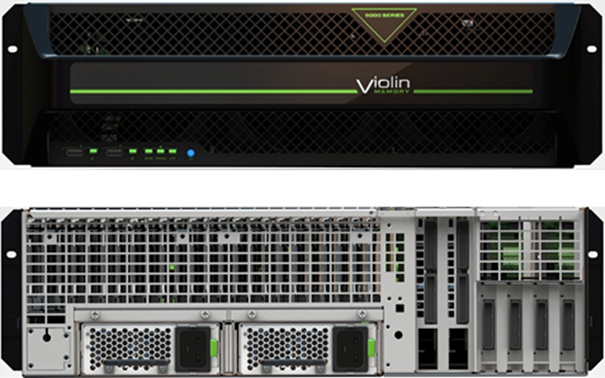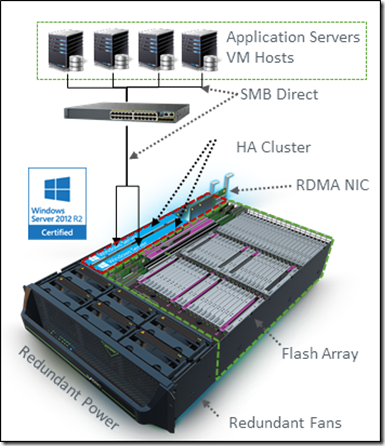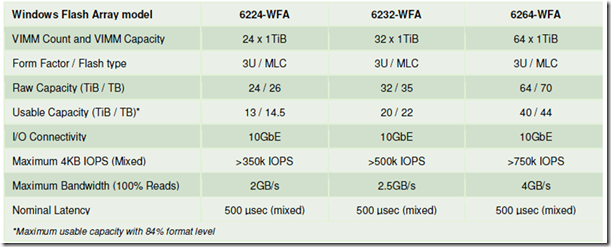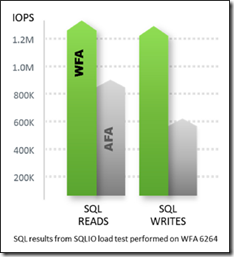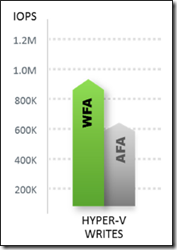Violin and Microsoft Jointly Develop a High-Performance, All-Flash Enterprise Storage Appliance Powered by Windows Storage Server 2012 R2
Hi Folks –
Violin Memory today announced the Violin Windows Flash Array (WFA)—an all-flash, high-performance storage appliance powered by Windows Storage Server 2012 R2.
Here are the highlights:
- The WFA is the result of a joint development effort between Violin and Microsoft, which spent more than 18 months working together on software optimizations to get the most out of the array’s unique performance profile.
- It takes advantage of SMB Direct (SMB 3.0 over RDMA) and Violin’s flash memory optimization algorithms to deliver an ideal combination of low latency, high IOPS, and low CPU use.
- Performance provided by the WFA makes it an ideal storage platform for major enterprise workloads, including Microsoft SQL Server, Hyper-V virtualization, and Virtual Desktop Infrastructure (VDI).
If you’re not already coveting a Windows Flash Array for your own IT infrastructure, let me put things another way: This incredibly powerful storage appliance delivers 70 terabytes (TB) raw storage capacity, nominal latencies of less than 500-microseconds, and more than 750,000 4K IOPS—all in a 3U, dual-node cluster that draws about 1500 watts and can be deployed in as little as 30 minutes, without an advanced degree in storage networking!
Now that I’ve covered the highlights, let’s take a deeper look at the WFA’s architecture, performance under key workloads, and other enterprise-ready attributes.
The Hardware
The Windows Flash Array is a 3U rack-mount storage appliance. Front and rear views (these are preliminary; the bezel may change slightly) are shown below:
Here’s a shot that shows the internal components of the Windows Flash Array, within the context of a basic deployment diagram.
Three of these components warrant further discussion:
- Dual storage controllers/compute nodes (Violin calls them “memory gateways”)
- A Violin Flash Array consisting of 60 Violin Intelligent Memory Modules (VIMMs), plus an additional 4 VIMMs as hot spares
- Four dual-port RDMA-enabled network controllers, with your choice of either 10 GbE or Infiniband.
Now let’s take a closer look at each component—and how it plays into the incredible performance provided by the WFA.
Dual Storage Controller/Compute Nodes
Windows Storage Server 2012 R2 runs on the Windows Flash Array’s dual storage controllers/compute nodes, which Violin calls “memory gateways” in its documentation. Each compute node has:
- Two Intel Xeon E5-2448L processors, each with 8 cores and a 20MB L3 cache.
- 24GB of memory (upgradeable to 48GB per compute node).
Combined with the low CPU utilization enabled by SMB Direct (more on this below), Violin’s choice of substantial 8-core Xeon processors provides significant processing power to be utilized by Windows Storage Server 2012 R2 features such as Data Deduplication (more on this below too).
Violin Flash Array
The WFA is based on Violin’s Flash Array 6000 series all flash storage array, which features Toshiba flash memory, global hot spares, and no single point of failure. In turn, the Flash Array 6000 (and thus the WFA) is based on Violin’s Flash Memory Fabric architecture—an all-silicon approach that uses patented flash optimization algorithms implemented in hardware, operating at line rate.
- At the system’s core lies a resilient, highly available deep mesh of thousands of flash dies that work in concert to continuously optimize performance, latency, and longevity.
- Violin Intelligent Memory Modules (VIMM) organize this mesh of individual dies into intelligent flash management units, providing a hardware-based Flash Translation Layer with garbage collection, wear leveling, and error/fault management.
- VIMMs are integrated into the patented Violin Switched Memory (vXM) architecture, which is designed from the ground-up for power efficiency and performance.
- Finally, VIMMs and the vXM layer work in conjunction with vRAID, Violin’s patented hardware-based RAID algorithm specifically designed to increase reliability and reduce latency.
- Collectively, these deeply integrated layers—the mesh of flash dies organized into VIMMs integrated with vXM and overlain by vRAID—make up the Violin Flash Memory Fabric.
RDMA-Enabled Network Controllers
Violin made sure that the Windows Flash Array isn’t constrained by network bandwidth. Network I/O is provided by eight high-speed network ports, for which you have two options:
- 4x Chelsio T-520CR Dual-Port 10 Gigabit Ethernet adapters
- 4x Mellanox ConnectX-3 Dual-Port VPI adapters (MCX354A-FCBT), which support up to 56Gb/s Infiniband or 40/56 Gigabit Ethernet per port
Both adapters support Remote Direct Memory Access (RDMA), which the WFA takes advantage of through SMB Direct—also known as SMB 3.0 over RDMA. With SMB Direct, which operates at PCI-E speeds, data stored remotely on the WFA can be read directly into the memory of an application server accessing the array. This reduces processor load by up to 30 percent, enabling the app server’s processor(s) to focus on their application workloads instead of storage I/O.
Choice of Three Models
The first Windows Flash Array model to be made available (6264-WFA) will ship with 64x 1TiB* VIMMs. (1TiB = 2^40 bytes, whereas 1TB = 10^12 bytes. Put another way, 1TiB ˜ 1.1TB.) Models with 24x and 32x VIMMs will follow within a month or so.
The following table shows all three models:
Performance on Key Workloads
As part of the joint development between Microsoft and Violin, Microsoft optimized the Windows Storage Server 2012 R2 kernel to maximize performance with the Windows Flash Array. Combine this with Violin’s optimized flash technology and the result is remote storage that performs like blazing-fast local storage!
SQL Server Performance
The Windows Flash Array is particularly well-suited for transaction-oriented workloads such as Microsoft SQL Server. According to Violin, customers beta-testing the Windows Flash Array with SQL Server 2012 report that the Windows Flash Array delivers up to 2x the write performance and up to 50 percent higher read performance when compared to an industry-standard, all-flash array connected via Fibre Channel. The graph below shows results from the SQLIO load test performed on the 6264-WFA model.
Violin worked closely with the SQL Server team as part of the joint development effort and will be participating in SQL Server 2014 launch events beginning April 25th.
A Violin whitepaper on applying the WFA to SQL Server workloads can be found here, and a solution brief on the same topic can be found here.
Hyper-V Performance
The WFA also excels in environments with a high degree of random I/O activity, including Hyper-V virtualization and private cloud architectures. As illustrated in the below graph, early testing shows the WFA delivering up to 40 percent greater write performance under Hyper-V than an industry standard, all flash array.
In addition, the use of SMB Direct can reduce CPU use by up to 30 percent, leaving more cycles for VM workloads. Finally, because the WFA is based on Windows Storage Server 2012 R2, you also get Storage Live Migration, which lets you bypass VM hosts for increased speed, efficiency, and flexibility in placement of VMs.
A Violin whitepaper on applying the WFA to Hyper-V workloads can be found here, and a solution brief on the same topic can be found here.
Virtual Desktop Infrastructure (VDI)
VDI workloads also have a high degree of random I/O activity, making the WFA a great choice for those workloads too. In fact, Microsoft and Violin are currently testing WFA performance under a VDI workload at the Microsoft Enterprise Engineering Center (EEC) in Redmond, with the goal of supporting 10,000 running VDI VMs on one Windows Flash Array! Test results are expected within the next few months, so be on the lookout for another blog article.
Also, don’t forget that Data Deduplication in Windows Storage Server 2012 R2 added support for deduplicating running VDI VMs, with an up to 90 percent increase in storage efficiency. Put another way, this capability enables you to support approximately 10x the number of VMs with a given amount of storage space.
Matthias Wollnik, Senior Program Manager for Data Deduplication in Windows Server 2012 R2 (and thus in Windows Storage Server 2012 R2), does a great job explaining the benefits of Data Deduplication in a VDI environment in this Q&A blog post.
Uncompromised Scalability, Availability, and Manageability
With faster storage performance, you can optimize CPU investments more effectively across workloads. However, performance on its own is rarely enough. Fortunately, the Windows Flash Array also delivers enterprise-class scalability and availability, along with superior ease-of-management.
Flexibility to Scale-Up or Scale-Out
The WFA supports Storage Spaces in Windows Storage Server 2012 R2, allowing you to start with one of the smaller units and scale up to meet growing demand. The WFA also supports Microsoft’s Scale-Out File Server (SoFS) architecture, enabling you to easily scale-out to four arrays/eight nodes per cluster. (This is the level to which Violin has tested cluster scalability; the actual limits for Failover Clustering in Windows Storage Server 2012 R2 is 64 nodes per failover cluster.)
Business-Critical Availability
The Windows Flash Array also incorporates multilayered hardware and software resiliency to deliver the availability levels required for business-critical applications. This is achieved through the use of:
- Redundant hot-pluggable fans and power supplies, non-disruptive (NDU) firmware upgrades, and a hardware design that avoids any single point-of-failure.
- Active/Active clustering (via Windows Failover Clustering) for continuous application uptime.
- SMB Multichannel to ensure that cluster node connectivity is maintained.
- Non-disruptive volume extensibility (provided through SoFS or thinly provisioned storage spaces), enabling you to add capacity to existing volumes without taking them offline.
Powerful, Familiar Management Tools
Last but not least, system administrators who are already familiar with Windows Server can deploy and manage one or more Windows Flash Arrays using existing Microsoft deployment and management tools, without having to learn any new skills.
Capabilities include:
Rapid deployment. Windows Storage Server 2012 R2 is preinstalled on both compute nodes
to speed deployment. Violin also implemented a custom out-of-the-box experience, which enables you to have an active/active cluster up and running in about 30 minutes.
Familiar management tools. Even with the incredible performance provided by the WFA, it won’t require you to learn any complicated new technologies or management tools. Instead, you can use the Microsoft management tools and technologies with which you’re already familiar, including Server Manager, Microsoft System Center, or Windows PowerShell.
Closing Thoughts
Violin’s Windows Flash Array is clearly a game-changer for enterprise storage. Given its incredible performance and other enterprise “must-haves,” it’s clear that the year-and-a-half that Microsoft and Violin spent jointly developing it was well worth the effort!
So if you’re looking for enterprise storage that offers higher storage capacity and utilization, a smaller and less expensive IT footprint, easy integration into Windows Server-based IT infrastructures, and (according to Violin) a cost savings of up to 80 percent compared to a traditional SAN, I encourage you to visit the Violin website and check out the WFA for yourself!
Cheers,
Scott M. Johnson
Senior Program Manager
Windows Storage Server
@supersquatchy
